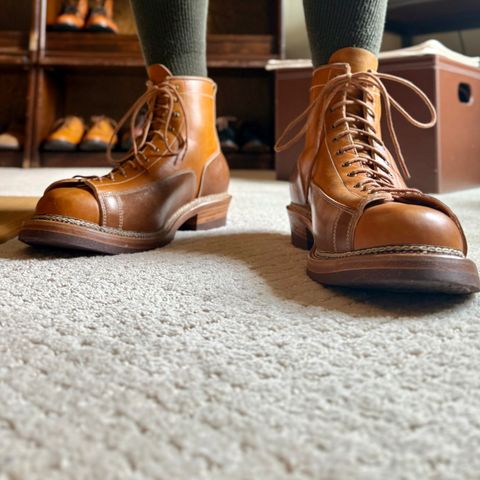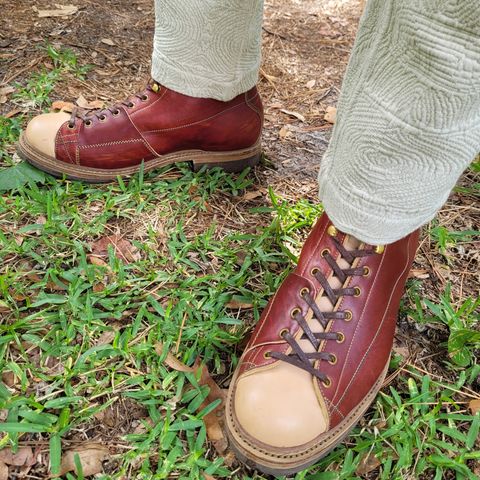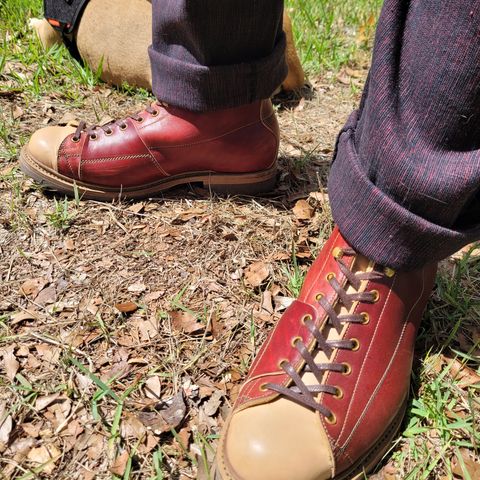About
Conceria Cloe Natural Horsebutt is an undyed vegetable-tanned horsehide leather produced by Conceria Cloe, an Italian tannery based in Ponte a Égola, Tuscany. The leather features a natural, unfinished aesthetic without applied pigments or dyes, showcasing the organic appearance of the raw material. Natural horsebutt from Conceria Cloe is characterized by its soft temper, subtle grain variation, and distinctive patina development, making it a popular choice among heritage footwear manufacturers and leather goods makers.
About
Conceria Cloe Natural Horsebutt is an undyed vegetable-tanned horsehide leather produced by Conceria Cloe, an Italian tannery based in Ponte a Égola, Tuscany. The leather features a natural, unfinished aesthetic without applied pigments or dyes, showcasing the organic appearance of the raw material. Natural horsebutt from Conceria Cloe is characterized by its soft temper, subtle grain variation, and distinctive patina development, making it a popular choice among heritage footwear manufacturers and leather goods makers.
The leather is used in premium boot construction and artisan leather goods, valued for its combination of durability and aesthetic aging properties. Manufacturers including Sagara and Meermin have utilized this leather in their footwear offerings.
Origin and production
Conceria Cloe S.R.L., located in Ponte a Égola in the Toscana region of Italy, specializes in horsehide products including horsebutt leather. The tannery is situated in La Toscana, the traditional heart of Italian leather production.
The natural horsebutt leather is fully vegetable tanned using traditional methods with no pigmentation applied during the tanning process. Vegetable tanning employs natural tannins from trees combined with modern technologies and a slow passage of time to transform animal hides into finished leather. The leather comes from the dense fibrous area of horse hides, specifically the hind section positioned above shell cordovan.
Conceria Cloe produces horsehide in multiple forms, including shell cordovan, horse avancorpo, and horse culatta, all using vegetable tanning processes in pit. The natural variant represents the leather in its undyed state, preserving the authentic color and texture of the material.
Characteristics
Natural horsebutt from Conceria Cloe exhibits very soft temper despite being horsehide, with subtle grain variation and a dry, matte touch. The leather features dense fiber construction that is simultaneously soft, gummy, and stretchy, contributing to both strength and flexibility.
The grain pattern displays high irregularity with significant variation across different areas of the hide. Natural markings characteristic of horsebutt include spider web veining, dark spots, scars, and cuts. The reverse (flesh) side sometimes shows residual traces of shell cordovan bleeding onto the fibers, creating a unique and varied aesthetic with sections of shell cordovan residue, suede areas, and glazed or smooth sections.
Conceria Cloe's natural reverse horsebutt ranges from 1.8 to 2.0 millimeters in thickness, which is lighter than typical horsebutt leather that can exceed 3 millimeters. This thinner gauge provides minimal break-in requirements while maintaining structural integrity. The leather demonstrates nice firmness with slight suppleness and is extremely flexible and resisting.
The material exhibits distinctive sheen and transparency characteristics. The leather has high oil content, contributing to its susceptibility to patina development.
Patina development
The leather develops a lustrous patina with an almost metallic sheen over time. Natural horsebutt darkens significantly with wear and exposure to environmental factors. The vegetable tanning process allows the leather to develop distinctive patina characteristics as it ages.
Being an aniline-finished product, the leather will change and deepen in appearance with use and age. Exposure to air, light, skin oils, and other environmental factors causes the leather to darken and develop character. Natural leather begins to tan when exposed to sunlight, changing from natural to pink to reddish tones over time.
The high oil content makes the leather highly prone to patina, meaning the material responds quickly to handling and environmental exposure. The patination process is directly influenced by how the owner uses the product, with no two pieces aging identically.
Applications
Natural horsebutt from Conceria Cloe is used for heritage footwear construction, particularly using the reverse or flesh side in boot uppers. The leather appears in handwelted flat welt construction with 270-degree outsole stitching. Full vegetable-tanned construction is possible using natural horsebutt for uppers, insoles, welts, and outsoles throughout the entire boot.
Sagara offers The Boondockers in Cloe Nuda - Naturale featuring this leather, while Meermin has produced Norvegese service boots using Conceria Cloe horsebutt. The leather is also suitable for wallet production, including bifold and Japanese wallet styles using the reverse cut, though applications are limited due to the small usable area per hide.
The material is well-suited for durable applications including boots, shoes, wallets, belts, and other small leather goods. Heritage boot manufacturers value the leather for its ability to age beautifully while maintaining structural integrity.
References
"Horse Culatta - Cloe S.R.L". Mill Handmade. Retrieved October 23, 2025.
"The Boondockers Cloe Nuda - Naturale". Sagara Bootmaker. Retrieved October 23, 2025.
"Maryam - Horserump TPR - Veg Tanned Premium Horse Butt Leather (HIDES)". Rocky Mountain Leather Supply. Retrieved October 23, 2025.






































































